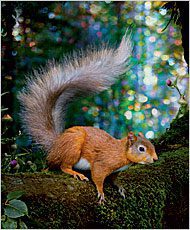In an effort to save the native Red Squirrel, the invasive Gray Squirrel in the UK been subject to a holocaust (esp in Northumbria, the last stronghold of the reds): Over 20,000 Gray Squirrels are Culled. Gray Squirrels were brought over from America in the early 19th century “to amuse the rich;” now they’ve gotten out of hand, and the native Red (arguably the cuter, daintier and foxier of the two species) is close to extinction.
There was a Channel 4 doc about the battle.
Chicago Sun Times summed up the problem pithily:
“…consider now the British red squirrel, a vibrant, cheeky little creature whose scarlet coat simply glows. The sad truth of the matter is that the big, pushy American gray squirrel is taking over and causing marked species decline.“The red squirrel is native to Britain, but its future is increasingly uncertain as the introduced American gray squirrel expands its range across the mainland. There are estimated to be only 140,000 red squirrels left in Britain, with over 2.5 million grays. The Forestry Commission is working with partners in projects across Britain to develop a long-term conservation strategy that deters grays and encourages reds.”
The red squirrel may be an English icon, just like a red fox, but it is dying out here in Great Britain, as the above Forestry Commission report makes clear. This is hardly a new phenomenon. I think of Bill Bryson’s excellent Australia travel book, In a Sunburnt Country, which documents case after case of species annihilation caused by the introduction of Western plants and animals.
This time, though, the little red British squirrel is at the mercy of the behemoth American gray. Of course the culture critics can make all sorts of fun metaphors with that one. But I see this phenomenon as more of a scientific fact of life, albeit one that I hope we can alter. So I cheer on the underdog red squirrel, especially the cute ones that scampered under our lodge window in the Scottish Highlands, snatching up the peanuts we put out for them and running up the nearby silver birch to crack into the shells as we cheered from within.” – http://blogs.suntimes.com/fosnight/2008/02/red_squirrel_versus_grey_squir.html
A choice commentator elsewhere called the grays “foreign interlopers, not even European.’
Rife with potential analogies and clear subtexts, the (American) Gray Squirrel is a virus carrier, to which it is immune. With its arsenal of squirrelpox and its talent for landgrabbing, it has succeeded in exterminating most of the UK Reds.
So, the Gray Squirrel is being culled.
In Northern England, there is a force called the Red Squirrel Protection Unit, founded by the 6th Baron Redesdale of Northumberland (The Baron has a lengthy profile for his squirrely patriotism in the New York Times, 2007).
I found out that at least his co-founder, the verminator Paul Parker eats the culled Grays.
‘We developed what we called our killing strategy. Hit them in the woods. Dipton Woods: we took 2,000 out. If you clear a woodland you suck all the surrounding population to it. Then you hit them again. Suck ’em in, hit them.’ – The Guardian
One of the Red Squirrel protection unit culling gray squirrels in Northumberland.
Photograph: Gary Galton
red squirrels, after all, are not scarce outside the British Isles. In fact, worldwide — reds live throughout Europe and Asia — they probably outnumber grays. It is only in Britain (and more recently in Italy, where grays were introduced in 1948) that the red is considered threatened.


